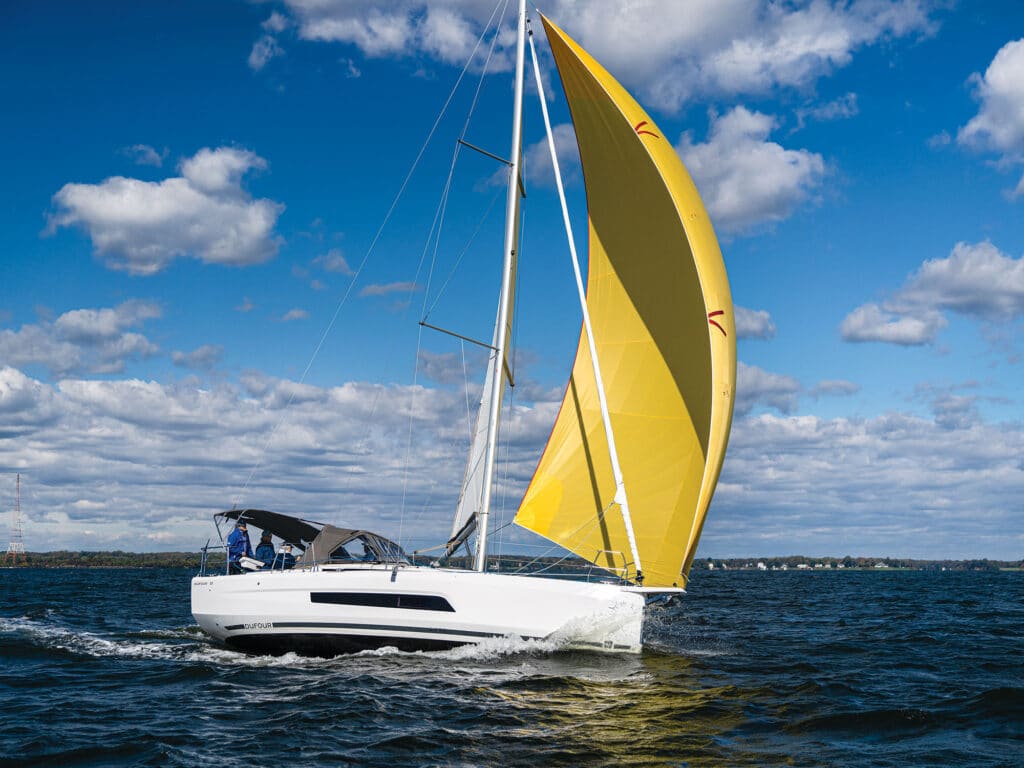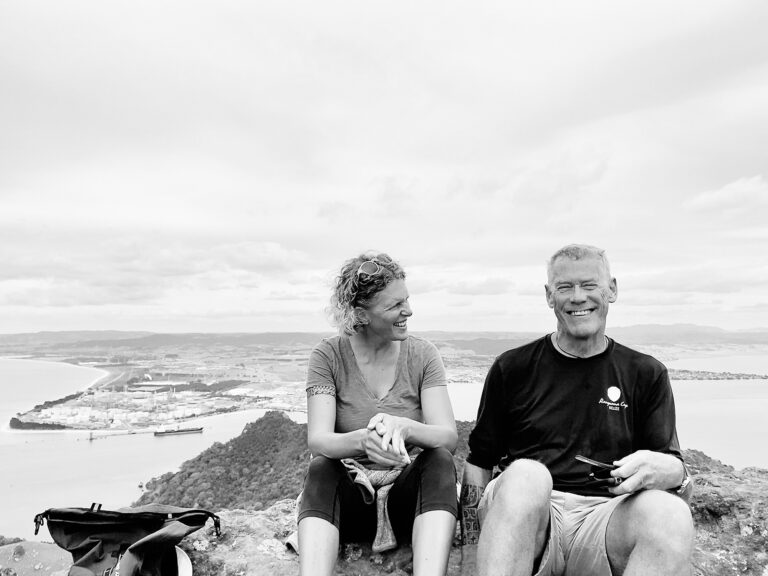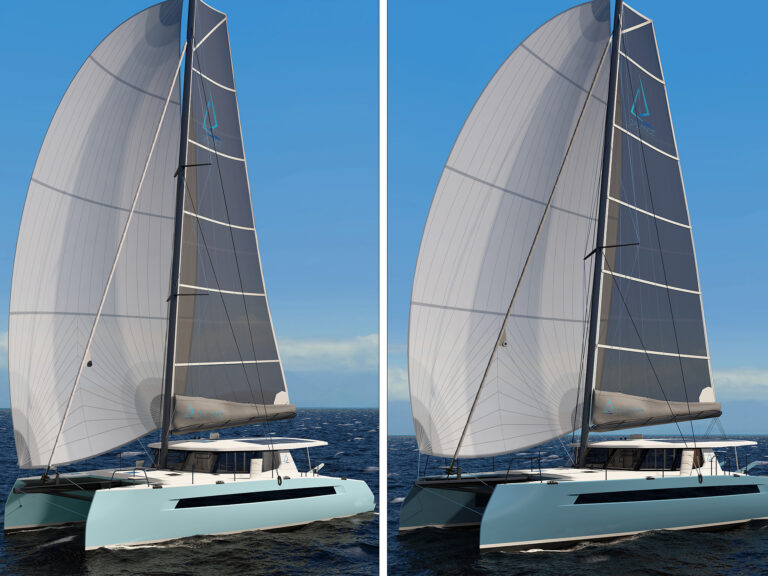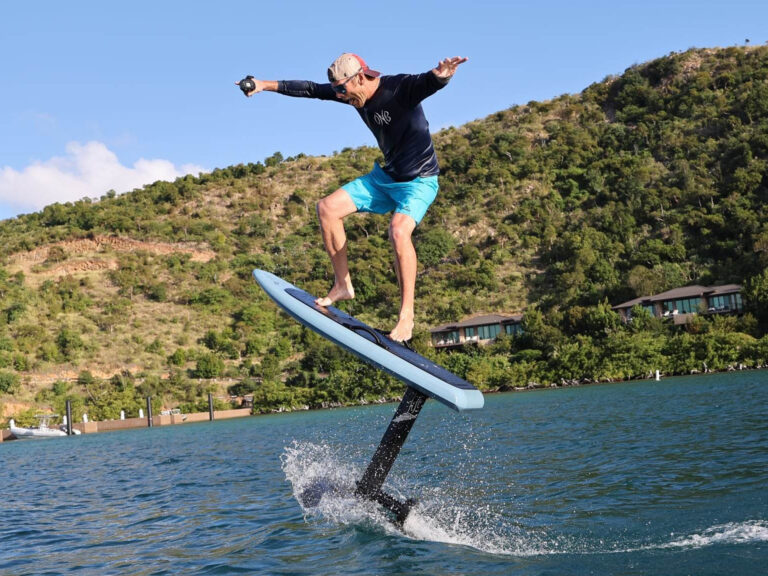
For most of the decade starting around 2010, Dufour Yachts approached the business of making and marketing its performance cruising boats in a uniform manner. Nowhere was this more obvious than at gatherings such as the annual sailboat show in Annapolis, Maryland, where the company’s Grand Large line of boats was displayed, all clearly from the same lineage. They had nearly identical hull shapes and profiles, and matching beige canvas dodgers and Bimini tops. The only major thing that set them apart was the length of their waterlines. I quite liked those boats, which sailed well and offered extremely good value; in fact, I often had Dufour at the top of my list of favorite French production boatyards.
Then, in 2018, Dufour was acquired by another iconic French yard—catamaran builder Fountaine Pajot—which slowly but surely is stamping its own imprint on the brand. The latest example of this evolution is the Dufour 37 that was introduced in Annapolis this past fall, replacing the 360 in the lineup (and measuring closer to 35 feet than 37 feet).
Fountaine Pajot made no secret about its intention to modernize the Dufour line, which was clearly a priority in the aesthetics of the 37. The freeboard is ample, the angular windows in the hull and coachroof are flashy and accent one another, and the integrated bowsprit forward gives the whole shooting match a sense of purpose and performance. Throw in a forward sun deck with an inflatable lounging pad that can be stashed away when not in use (the catamaran guys in the building surely had a say here), and you have a contemporary package in looks and feel.
But dive in a little closer, and the recent Dufour DNA is also evident. Which isn’t surprising, considering that the naval architect is perennial Dufour designer Umberto Felci, the creative force behind the previous Grand Large assemblage. This boat has all the hallmarks we’ve come to expect in a Dufour offering in recent years: a traditional full-battened mainsail (not a furling main), a plumb bow, twin wheels and a single rudder, a roomy cockpit, a “plancha” grill aft, and a drop-down transom.
I’m thinking about features like these because nowadays, I’m spending about half the year living aboard a “classic plastic” 36-foot production cruiser from the mid-1970s (see “Off Watch,” page 82), an experience that has convinced me that this size range is pretty ideal for a cruising couple. But the Dufour 37 has also driven home how much more voluminous and comfortable—thanks to major advancements in design and execution—a modern yacht in the 35-foot size range can be. Almost all that extra volume is attributable to the boat’s considerable beam (a generous 12 feet, 6 inches or a 3-to-1 length-beam ratio) that makes for fuller forward sections and that is carried well aft. Compared with my old Pearson, it’s absolutely astounding how much more square footage has been added to the interior of boats of similar lengths.
The 37 is available in two layouts: a three-stateroom version with a pair of double staterooms aft, and a two-stateroom plan that was on our test boat (each has a single head, which is significantly larger in the latter version). Settees and tables in the salon and cockpit convert to bunks, which means the three-stateroom model can sleep eight people. I believe this reflects the communal French approach to cruising, where it’s not uncommon to see a small platoon of friends and family take to sea. For the ways I use a boat—with a significant other and occasional guests—the two-stateroom layout is ideal, and all the better for the massive stowage compartment you get in lieu of one of those aft staterooms.
Construction is straightforward, with an infused hull that incorporates a foam core above the waterline and a deck injected with closed-cell foam. The keel is fitted with a substantial ballast bulb for stiffness and stability. The standard engine is an 18.8 hp Volvo Penta, but our test boat had the optional 30 hp diesel (both are saildrive configurations) that caught the eye of Boat of the Year judge Ed Sherman. “There are a lot of nice, small touches here that make a difference,” he said. “For example, while motoring, the boat was among the quietest in our group this year, rivaling some of its competitors costing significantly more money.”
At the end of the day, however, no matter what building methods have been employed or how many beds you’ve got, for me, on any sailboat, what matters most is simply the quality of the sailing experience. Otherwise, why buy a new sailboat? And I have to say, on that count, the Dufour 37 delivers big time.
There are three performance packages available—Easy (with self-tacking jib), Ocean and Performance—with upgraded winch and hardware features as you ascend the performance scale. Our test boat was tricked out with an overlapping headsail, a whopper of an asymmetric spinnaker, and the related gear necessary for optimal trimming, which felt right; this isn’t a boat where you want to put a governor on the sailing experience.
Chesapeake Bay was in a cooperative mood, with a solid 12 to 14 knots of southwesterly breeze pumping across the waters. Upwind, the boat was quick and easy to steer, but the highlight was setting the kite and attaining liftoff. Powered up, the boat was fast, reaching at more than 8 knots, and it tracked like a racehorse, but with a helm still under fingertip control. Our Boat of the Year panel enjoyed many a rocking great sail, and the Dufour 37 provided one of the more memorable.
In short, with its new landlords in place, Dufour still has changes coming. Yet, as the company approaches its 60th year of operation, it remains on a straight, smooth course.
Dufour 34 Specifications
| LOA | 35’4″ |
| LWL | 30’6″ |
| BEAM | 12’6″ |
| DRAFT | 6’7″ |
| SAIL AREA | 646 sq. ft. |
| BALLAST | 4,099 lb. |
| DISPLACEMENT | 14,275 lb. |
| D/L | 178 |
| SA/D | 17.6 |
| WATER | 48 gal. |
| FUEL | 42 gal. |
| MAST HEIGHT | 64’10” |
| ENGINE | 18.8 hp Volvo (saildrive) |
| DESIGNER | Felci Yacht Design |
| PRICE | $220,000 (as tested) |
| WEBSITE | dufour-yachts.com |
Herb McCormick is a yachting correspondent for The New York Times and former editor-in-chief of Cruising World. An author of five nautical books, he’s owned several sailboats, including his current Pearson 365 and Pearson Ensign.








